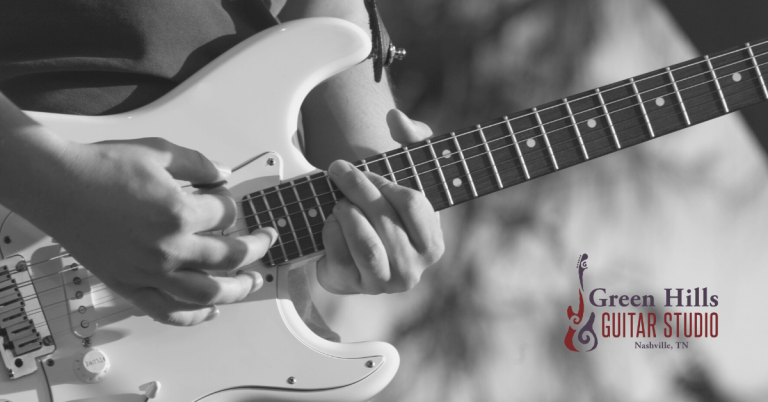How To See Immediate Improvement In Your Guitar Playing
We are all looking for ways to see improvement in our guitar playing. The problem is that we keep playing the same exercises and licks repeatedly, thinking it will get better.
Often, my guitar students practice hard and consistently, but they aren’t seeing the results as quickly as they want. Part of it may be unrealistic expectations, but part of it could very well be a student needs a different approach to something they’ve been working on. If you are building your skill set, you can take new approaches and respond differently.
Read on to learn how you can start to see more improvement in your guitar playing.
How can I quickly improve my guitar playing?
You would be amazed at how quickly you can improve your guitar playing by being intentional about what you’re playing, being aware of your habits, and finding what areas you need to isolate and improve.
I often record my guitar students so they can objectively listen to their playing. It is not an opportunity for them or me to be hypercritical. I like to start recording my students as they’re beginning a new piece of music. The end result takes care of itself if you focus on the little things along the way.
Great guitar playing isn’t about perfection or performance. It’s about being present in the music and learning as you go. Even if you’re riffing on power chords, attitude goes a long way! This approach also helps my students become less anxious, fearful, and negatively self-critical.
Wouldn’t it be weird if athletes didn’t watch films of themselves? Imagine if a running back had no concept of his footwork. Or a golfer that didn’t watch videos to analyze their swing. That’s the approach…just checking in on what we are doing, gaining awareness, and finding areas to improve.
Here is a great example by one of my students, Matt. He has been gracious enough to allow me to share this with you so you can also try it. Matt has been working on everything necessary to be a better guitarist: rhythm, technique, ear training, music theory, etc.
In his last lesson, he wanted to learn the Stevie Ray Vaughan version of “Little Wing” by Jimi Hendrix. We worked on it briefly, talking about the chord progression, chord and scale shapes, what notes to let ring, and some fingerings, and then I saw him a few days later.
Your guitar playing will improve if you pay attention to the little things
When Matt returned for the next lesson, he had put the time in and understood the intro well. The goal wasn’t total perfection (there is no such thing!) or expectations of performance-level playing, just a good understanding so we could work on some of the aspects of the piece.
In the first video, Matt played the intro pretty softly and with a slightly narrow dynamic range. It felt like this is where he had settled after a few days of practice and working on the music. Playing Hendrix is demanding and difficult…there is a lot going on. I wanted Matt to tap into a more dynamic range, smoother phrasing, punchiness at the right moments, and a less spongey rhythm.
Instead of addressing some of the timing, phrasing, and rhythm issues on a micro level, I simply asked him to play it again but to play harder. Here is that performance:
Not all of the “problems” guitar students encounter will be resolved by a linear technique exercise
Playing music isn’t always about chops. Notice how quickly Matt became more musical in the ways mentioned above. This was just seconds after the first time through. Notice how some of the punchiness, dynamics, and phrasing seemed to fix itself just by being more musically present. We didn’t turn it into a technique exercise.
Making adjustments to HOW you are treating the dynamics and phrasing is tough to do! It really throws a wrench into your technique, and you must figure out how to adjust. That’s the beauty of this approach. That’s exactly why it’s so important to do. It really changes everything quickly.
Not all of the “problems” many of my students encounter will be resolved by a linear technique exercise. It is not always about chops. You have to be IN the music, and it will REVEAL what needs to happen if you listen and pay attention.
DO NOT wait to start paying attention to important musical elements other than technique
For the third time, I asked Matt to find a good compromise between the two approaches. I asked Matt to hear the music in his head as he was playing and to really think about the phrasing and dynamics to shape them in more of an ebb and flow.
Where do you think it should build and come down? Where does it feel the phrase is going? The goal is to identify and connect the musical phrases and not just approach them from note to note.
Here is the third time through:
Keep in mind all of this happened one right after the other. By focusing more on the musical aspects of phrasing and dynamics and not making too big of a deal out of the technical (which is what we usually do and just beat something to a pulp), Matt made adjustments that solved many of the underlying issues quickly.
My point in this lesson for Matt, and you, is DO NOT wait to start paying attention to important elements other than technique. Paying attention to phrasing, vibrato, tone, and dynamics will INFORM your technique and sense of timing and rhythm. Information is what is needed to pull it off musically.
This approach will save you a lot of time and frustration when practicing and learning a new piece of music. Try to get inside the music with elements other than just technique.
Check out this article to learn more about wasting your practice sessions on guitar technique.
Remember, we are working to play MUSIC and find our own voice and style on guitar, so there isn’t a right or wrong. We get closer when we can make informed and conscious playing choices.
Here are some examples.
Ask yourself, how did these guitar players get there?
Thanks to Matt for allowing me to share these videos with you. We all feel vulnerable when we are learning something new and don’t quite have it under our fingers yet. It takes a lot of guts to do this in real-time.
If Matt and I hadn’t been working on these other aspects for a while now, he wouldn’t have been able to do this so effectively. He could pull many elements of the music together because of his willingness and ability to approach it in a new way and not just keep playing it the same way over and over.
I hope this bit of advice helps you start to see some improvement in your guitar playing. Until next time, happy guitar-ing!








